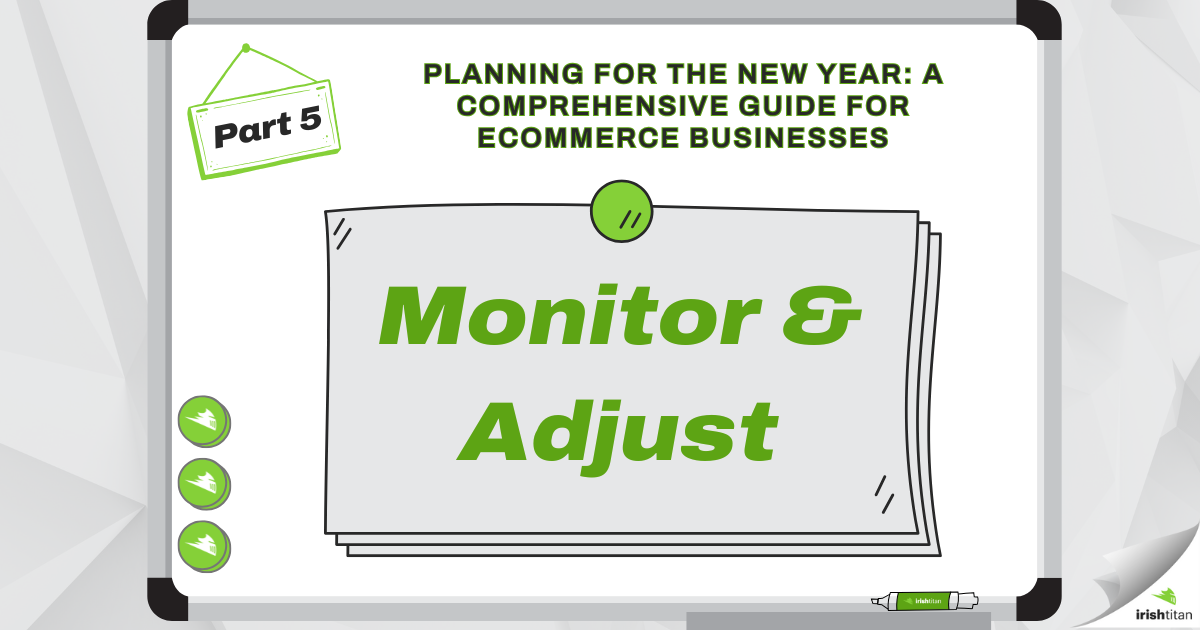Planning for the New Year Part 1: Reflection & Planning
Planning for the New Year: A Comprehensive Guide for Ecommerce Businesses
Part 1: Reflection & Planning
As we approach 2025, it’s time to gear up for the new year. Effective planning is essential to aligning your goals, adapting to industry trends, and optimizing your operations. We're here to help you navigate the planning process so you can set your ecommerce business up for success.
Here’s your 2025 roadmap, with five key areas to focus on:
- Reflection and Planning
- Optimization and Strategic Planning
- Streamlining and Updates
- Focus and Expansion
- Monitoring and Adjustment
Let’s kick things off with Part 1: Reflection and Planning, where we’ll explore the foundational elements for setting up your business for the year ahead.
1. Reflection on the Past Year
To make the most of the coming year, it’s critical to start with an honest look at how the previous year went. Reflect on the goals you set and the outcomes you achieved. Key areas to review include revenue growth, product launches, customer acquisition, and operational improvements.
For each goal, ask yourself:
- What Went Well? Celebrate your wins, both big and small.
- What Fell Short? Identify areas that need work. Was it market conditions, internal inefficiencies, or something else?
Next, take a close look at your sales performance to get a better sense of your financial health and customer preferences:
- Best-Selling Products: Which products really resonated? Are there any patterns you can leverage (like seasonality)?
- Sales Trends: What does the data tell you about overall sales, peak periods, and market influences?
- Underperforming Items: Identify the products that didn’t hit the mark. What adjustments can you make in terms of demand, pricing, or marketing?
To dive even deeper, use both quantitative metrics (KPIs like revenue, retention, and operational efficiency) and qualitative feedback (customer, employee, and stakeholder insights). Tools like surveys, reviews, or even open conversations can uncover satisfaction, pain points, and internal challenges, helping you spot broader trends or opportunities.
Finally, evaluate your marketing efforts across channels:
- Traffic Sources: Which channels are driving the most traffic? (Think: social media, paid ads, organic search)
- Conversions: Analyze which channels turn visitors into customers.
- ROI: How do your marketing channels stack up in terms of revenue vs. cost?
2. Goal Setting and Planning
Now it’s time to get serious about your goals for 2025. Start by defining clear, measurable objectives that align with your broader vision. Set specific goals in key areas:
- Customer Acquisition: Define your targets for attracting new customers and growing your sales.
- Customer Retention: Focus on building customer loyalty and encouraging repeat business.
- Operational Efficiency: Identify areas where you can streamline processes and reduce costs.
A solid framework to use here is SMART (Specific, Measurable, Achievable, Relevant, Time-bound) to keep your goals grounded in reality
Prioritize Goals:
Once your goals are set, it’s important to prioritize them. Focus on the ones with the most impact and alignment with your broader strategy. Break down the goals into actionable chunks:
- Quarterly Targets: Set big-picture goals for each quarter.
- Monthly Targets: Break those quarterly goals down into bite-sized tasks.
- Weekly Targets: Make your weekly progress clear and actionable.
Track Progress with KPIs:
Establish specific Key Performance Indicators (KPIs) for each area, like revenue, average order value, conversion rates, and fulfillment times. These KPIs will help you monitor progress and make data-driven adjustments along the way, ensuring that everyone stays focused and aligned with your overall business objectives.
3. Budget and Financial Planning:
Effective budgeting is the backbone of sustainable growth. Start by forecasting your revenue, analyzing past sales trends, and considering seasonal fluctuations and market conditions. Use historical data alongside real-time insights to make your forecast as accurate as possible.
Allocate your resources strategically:
- Operations: Budget for staff, technology, and infrastructure.
- Marketing: Invest in the channels that are driving growth.
- R&D: Allocate funds to innovation and new product development.
- Unexpected Expenses: Always have a contingency fund for the things you didn’t see coming.
Once your resources are allocated, review your expenses. Cut unnecessary costs and prioritize investments that bring the highest returns, whether in marketing, tech, or talent development.
To wrap it all up, a strategic approach to reflection, goal setting, and resource management is critical to your ecommerce business’s success. Reflect on the past year to identify wins and areas for improvement. Set clear, actionable goals using the SMART framework and break them down into manageable steps. Use KPIs to track your progress and stay flexible enough to adjust your course when needed. With careful budgeting and wise allocation of resources, you'll set a solid foundation for growth in the new year.
More reads





More from Ecommerce...

In the final part of our 2025 planning guide, we’re diving into a crucial practice for any successful ecommerce business: staying dynamic in an ever-changing market.

In Part 4 of our 5part series, we’re diving into a key dual goal for ecommerce businesses: growing your customer base while strengthening relationships with your current audience.

In today’s fast-paced ecommerce world, your website is the beating heart of your business. It’s not just where transactions happen; it’s the first place customers form an impression, where loyalty begins, and where the potential for growth lies.
